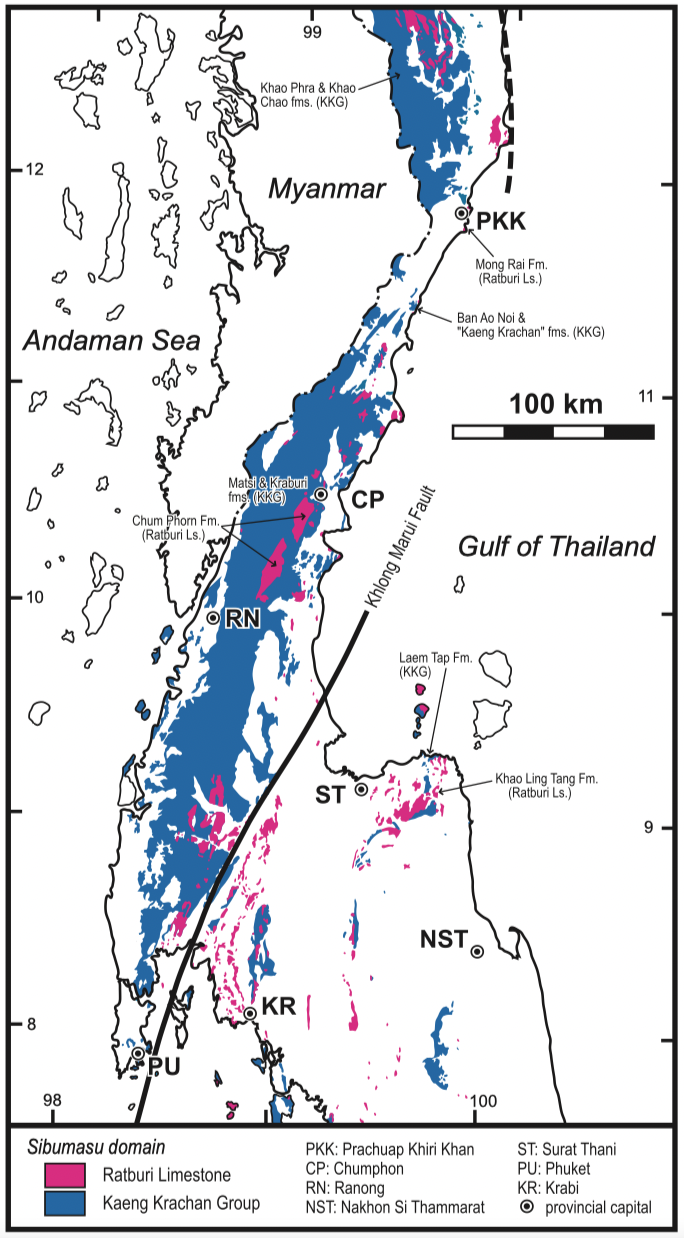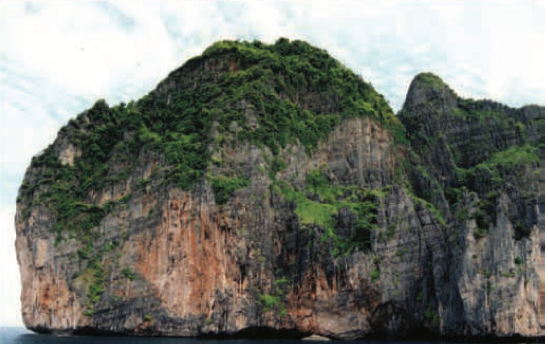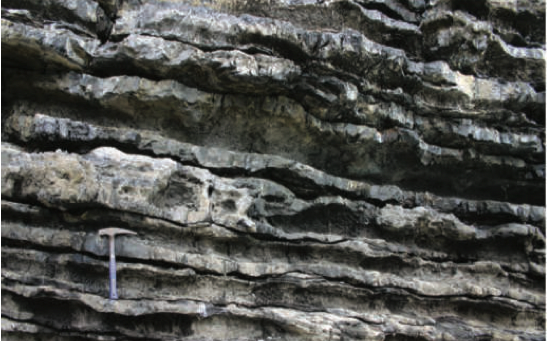Ratburi Limestone Fm
Type Locality and Naming
[Figure: Distribution of Carboniferous and Permian in upper, and part of lower, Peninsular Thailand. Data mainly based on 1:1 million scale geological map of Thailand (DMR 1999) with minor modifications (KKG: Kaeng Krachan Group) (from Ueno & Charoentitirat, 2011).]
Synonym: กลุม่หินราชบุร; Rat Buri (in earlier studies); Ratburi Gr
Lithology and Thickness
Other subdivisions (Although in the literature it is generally given group status, no completely satisfactory subdivision into component formations yet exists): (1) Bunopas (1981) subdivided (then called Sai Yok group) into 3 formations: Khao Muang Khrut Sandstone Fm, Sai Yok Limestone Fm and Tha Madua Sandstone Fm. (2) Chaodumrong and others (2004, 2007) subdivided into 5 formations: Thung Nang Ling Fm, Khao Muang Khrut Sandstone Fm, Phap Pha Fm, Phanom Wang Fm, and Um Luk Fm. (3) Ueno & Charoentitirat (2011) divided the Ratburi Limestone litho-stratigraphically into two members. The lower member, c. 260 m thick, consists of dark-grey, well-bedded limestone with frequent chert nodules/layers. Lime-mudstone and wackestone are the dominant microfacies. The upper member is more than 250 m thick and composed of grey, massive to weakly thick-bedded limestone. Bioclastic packstone and grainstone are characteristic. These two members probably correspond approximately to the Phap Pha Fm and Um Luk Fm of Chaodumrong et al. (2004, 2007)..
[Figure1: Well-bedded, dark-grey muddy limestone with prominent chert layers in lower member of Ratburi Limestone exposed at Ao Nui, northern part of Phi Phi Island (from Ueno & Charoentitirat, 2011).]
[Figure2: Upper member of Ratburi Limestone exposed in southern part of Phi Phi Island. Note its cliff-forming nature and massive to thick-bedded occurrence which are different from the lower member (from Ueno & Charoentitirat, 2011).]
Relationships and Distribution
Lower contact
Upper contact
[Figure: Geological column of Kaeng Krachan Group and Ratburi Limestone in Phi Phi Island off Krabi, southern Peninsular Thailand. Data mainly from Ejima (2005) with minor modification. (from Ueno & Charoentitirat, 2011) ]
Regional extent
GeoJSON
Fossils
Lower member: Fossils are common, mostly brachiopods, solitary corals and rare foraminifers including Langella, Pachyphloia and ?Multidiscus. Small burrows and trace fossils are also common.
Upper member: Several large fusulines in its basal part such as Pseudofusulina cf. heratica and Yangchienia sp.
Age
Depositional setting
Additional Information
A proliferation of formation names have been proposed for units within the Ratburi Group in the 1:250 000 scale geological maps published by the DMR, such as the Mong Rai Fm in the Prachuap Khiri Khan area by Silpalit et al. (1985), the Chumphorn Fm in the Chumphon area by Mahawat et al. (1985), the Khao Ling Tang Fm in the Surat Thani area by Nakinbodee et al. (1985), the Khao Nui Fm (the Khao Rub Chang Fm of the Malaysian and Thai Working Groups 2005) in the Satun–Songkhla area by Tonsuwan et al. (1985) and the Tarn To Fm in the Yala area by Muenlek et al. (1985). According to their brief lithological descriptions, these formations are mostly massive to bedded carbonates (mainly limestone with occasional chert nodules and often recrystallized and locally dolomitized), several hundred meters thick yielding foraminifers, corals, brachiopods, bryozoans and crinoids, and with minor sandstone and shale intercalations. However, the detailed stratigraphy remains largely uncertain and the correlation from area to area is not clear (Ueno & Charoentitirat, 2011).


